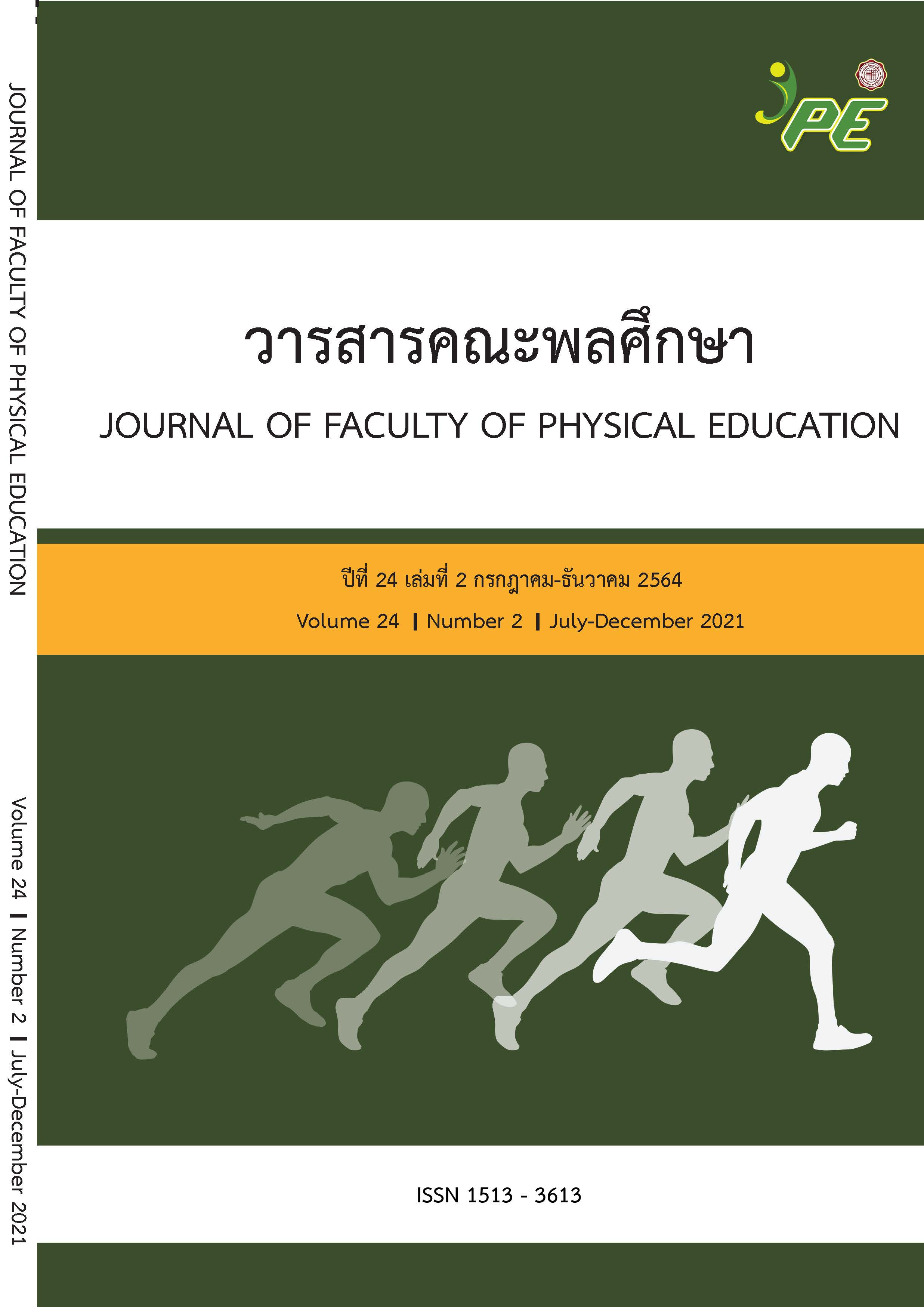KINEMATIC ANALYSIS OF JUMPING AND THE ACUTE EFFECTS OF JUMPING PROPRIOCEPTIVE TRAINING ON MAXIMUM FORCE, PEAK POWER AND JUMPING PERFORMANCES
Main Article Content
Abstract
Purpose: To study and compare the acute effects before and after a jumping proprioceptive training on
maximum force, peak power and jump performance.
Methods: The sample consisted of 30 athletes, divided into control group and experimental group, 15
participants each. Physical data were collected and tested for jumping ability without limiting knee angle
before the experiment. Test the angle of standing jump. They were tested on next 7 days for their free knee
jumping performance with the control group, a 90-degree knee jumping performance with the experimental
group. The experimental group was asked to the perception on 90 degree knee jump training, and then
retested their jump ability again. The pre and post test data analyzed with a statistical program computer
were computed mean, standard deviation, compare mean difference within experimental group by One Way
ANOVA repeated measurement and Bonferroni post hoc. Compare between groups were t-test independent,
the significance level .05.
Results: The comparing within the experimental group found that the jump performance before and after
jumping proprioceptive training were significantly difference (p< .05), but when compared between the
control and experimental groups, jumping performance were no significantly different
Conclusion: The jumping proprioceptive training had been the effect on jumping performance. However,
when comparing the training results with the control group, there were no significant difference.
Article Details

This work is licensed under a Creative Commons Attribution-NonCommercial-NoDerivatives 4.0 International License.
Any articles and comments This journal is the opinion of the author. The Faculty of Physical Education doesn't always have to agree. Anyone wishing to publish or distribute a message must obtain direct permission from the author.
References
(1) Thailand National Sports University, Ministry of Tourism and Sports. Thailand National Sports
University Strategy 2018–2022 (Review Edition) Fiscal year B.E. 2563. Chonburi: Thailand
National Sports University.
(2) Tongdecharoen O. editor. Report of Elite Sport Center Physical Fitness Test. Monthly Meeting. 2018
Sep 30; Elite Sport Center. Si Sa Ket. Thailand Nation Sport University, Si Sa Ket Campus; 2019.
(3) Krabuanrat J. Science of Coaching. Bangkok: Sintana Copy Center CO.,LTD. 2557.
(4) Riansoi Y. The Effects of Combined Plyometric and Proprioceptive Neuromuscular Facilitation
Training on Legs Muscular Power. Journal of Sports Science and Health. 2016; 17(2): 43-55.
(5) Hill A R, Daniel L L, Soon-M C. The Acute Effects of Different Squat Intensities on Vertical Jump
Performance. International Journal of Exercise Science. 2019; 2(11): Article 32.
(6) Warren B Y. Transfer of Strength and Power Training to Sports Performance. International
Journal of Sports Physiology and Performance, 2006; 1(2): 74-83.
(7) Warren B Y, Brian D, Greg J. H. Agility and Change-of-Direction Speed are Independent Skills:
Implications for Training for Agility in Invasion Sports. International Journal of Sports Science & Coaching.
; 10(1): 159-169.
(8) Subhashish K S. Kinematic and Kinetic Analysis of Squat Jump and Counter-movement Jump. Thesis
Bachelor of Technology in Biomedical Engineering. India: Rourkela, Odisha; 2015.
(9) Wagner T M, von Duvillard S P. Mueller E. Kinematic Analysis of Volleyball Spike Jump. International
Journal Sports Medicine. 2009; 30(10): 760-765.
(10) Rahmani A, Dalleau G, Viale F, Hautier C A & Lacour J-R. Validity and Reliability of a kinematic
Device for Measuring the Force Developed During Squatting. Journal of Applied Biomechanics.
Conference of the International Society of Biomechanics in Sports, Cologne, Germany, 2000; 16, 26-35.
(11) Frühschütz H, Becker L, Russ P. & Spitzenpfeil P. Evaluation of Silhouette-Based Markerless
Tracking for Kinematics in Sport. International Society of Biomechanics in Sports. 2017; 35(1): 231.
(12) Cohen J. Statistical power analysis for the behavioral sciences. 2nd ed. Hillsdale, NJ: Lawrence
Erlbaum Associates, Publishers; 1988.
(13) Laffaye G, Wagner P, Tombleson T. Countermovement Jump Height: Gender and Sport-Specific
Differences in The Force-Time Variables. The Journal of Strength and Conditioning Research. 2014;
(4). 1096-1105.
(14) Newton R U. Kraemer W J, Developing Explosive Muscular Power Implications for a Mixed Methods
Training Strategy. Strength and Conditioning Journal. 1994; 16(5): 20-31.
(15) Nobre T L, et al .The Use of Proprioceptive Neuromuscular Facilitation for Increasing Throwing
Performance. Rev Bras Med Esporte.2020; 26(4): 332-336.
(16) Daehan Kim, Guido Van Ryssegem and Junggi Hong .Overcoming the Myth of Proprioceptive
Training. Clinical Kinesiology.2011; 65(1): Spring, 18-28.
(17) Baroni B M, Rodrigues R, Franke R A, Geremia J M, Rassier D E, Vaz M A. Time Course of
Neuromuscular Adaptations to Knee Extensor Eccentric Training. International Journal of Sports Medicine.
; 34(10): 904–911.
(18) Romero-Franco N, Martínez-López E, Lomas- Vega R, Hita-Contreras F & Martínez- Amat A.
Effects of proprioceptive training program on core stability and center of gravity control in
sprinters. The Journal of Strength & Conditioning Research, 2012; 26(8): 2071-2077.
(19) Aman J E, Elangovan N, Yeh I-L & Konczak J. The effectiveness of proprioceptive training for
improving motor function: a systematic review. Frontiers in Human Neuroscience. 2015; 8(1075) 1-18.


